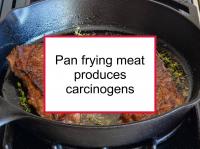A new study has reported on the heterocyclic amine (HCA) content of beef, chicken, pork, and fish prepared by various cooking methods. HCAs are produced in meat and fish cooked at high temperatures. The study examined the levels of HCAs in meat and fish prepared by pan frying, oven broiling, and oven baking at 338° to 446°F.
The primary HCAs found in cooked samples were (1) PhIP (2-amino-1-methyl-6-phenylimidazo [4,5-b]pyridine), which was detected at levels ranging from 1.49 to 10.89 ng/g; (2) MeIQx (2-amino-3,8-dimethylimidazo [4,5-f]quinoxaline), detected at 0-4.0 ng/g; and (3) DiMeIQx (2-amino-3,4,8-trimethyl-imidazo [4,5-f]quinoxaline), detected at 0-3.57 ng/g. (17.59 ng/g).
The type and level of HCA content in the food samples tested were found to be highly dependent on cooking conditions. The total HCA content in meat and fish cooked until well done was approximately 3.5 times higher than the levels of the same foods prepared to medium-rare doneness. Fried pork (13.91 ng/g) was found to have higher total HCA levels than fried beef (8.92 ng/g) and fried chicken (7.00 ng/g). Fried bacon had the highest total HCA content among the samples tested.
